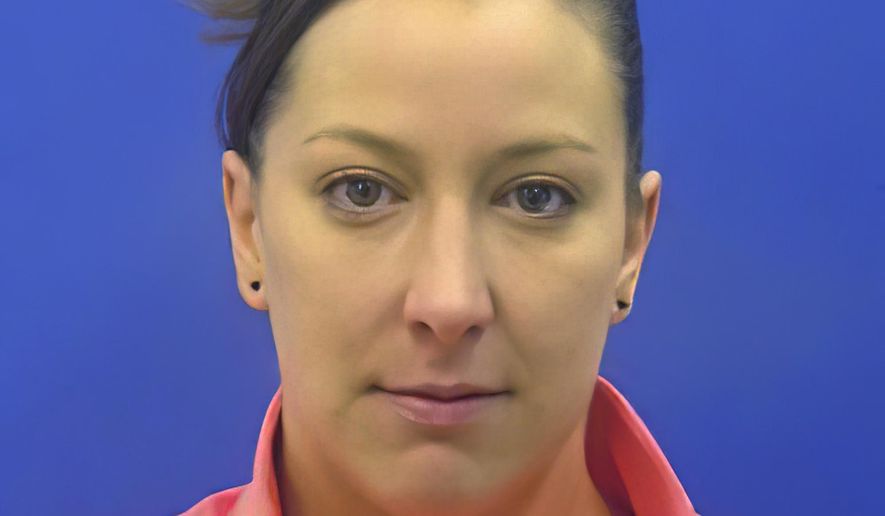Federal prosecutors will not file criminal charges against the U.S. Capitol Police officer who fatally shot protester Ashli Babbitt during the Jan. 6 riot at the Capitol, the Justice Department announced Wednesday.
An investigation by the U.S. attorney’s office for the District of Columbia and the Metropolitan Police Department concluded that there was insufficient evidence to support criminal charges, the Justice Department said in a statement.
The Justice Department said the investigation did not find any evidence contradicting that the still-unidentified officer believed it was necessary to shoot Babbitt, 35, “in self-defense or in defense of the Members of Congress and others evacuating the House chamber.”
Babbitt, a Trump supporter and Air Force veteran, was among five people who died during the riot and was the only one killed by police. Capitol Police Staff Sgt. Brian Sicknick died from injuries sustained during an encounter with rioters, although the exact cause of his death has not been determined.
Investigators reviewed video footage of the shooting posted on social media, statements from other officers on the scene, physical evidence from the shooting scene and results of the autopsy to reach their conclusions, the Justice Department said.
Babbitt was part of the mob that entered the Capitol and gained access to a hallway that leads to the chamber of the House of Representatives.
The mob was trying to enter the Speaker’s Lobby while Capitol Police officers were evacuating lawmakers from the chamber, according to the statement.
Members of the pro-Trump mob, which stormed the Capitol in an attempt to stop Congress from certifying Joseph R. Biden’s election victory, sought to enter the chamber by breaking through doors, the Justice Department said.
Rioters broke windows with their hands, flagpoles and other objects, the statement said. Babbitt tried to climb through one of the doors where glass was broken out, the Justice Department concluded.
The officer fired one round from his service pistol and struck Babbitt in the left shoulder, causing her to fall back from the doorway onto the floor.
Video clips of the riot posted online show rioters breaking through the Speaker’s Lobby’s glass doors, which were barricaded from the inside with chairs. As Babbitt tried to climb through the shattered glass, a gloved hand holding a gun enters the video frame and fires a shot into the crowd.
Babbitt immediately collapsed. The gloved hand holding a weapon is the only image of the officer in the video.
A Capitol Police emergency response team tried to administer aid to Babbitt. She was transported to Washington Hospital Center, where she died from her injuries, the Justice Department said.
“Acknowledging the tragic loss of life and offering condolences to Ms. Babbitt’s family, the U.S. Attorney’s Office and U.S. Department of Justice have therefore closed the investigation into this matter,” the statement said.
Babbitt’s family was notified of the decision, the statement said. Attempts by The Washington Times to reach members of her family Wednesday were unsuccessful.
The Justice Department said the investigation was to determine whether the officer violated any federal laws, including civil rights violations.
Authorities have not released the name of the officer who fired the fatal shot. There is no federal standard for releasing the names of officers involved in fatal shootings.
Police involved in other high-profile fatal encounters with unarmed civilians sometimes are quickly identified.
Minnesota officials this week identified within 24 hours the police officer who fatally shot a 20-year-old unarmed Black man during a traffic stop.
Kendall Coffey, a former U.S. attorney for Miami, said the difference is that the Babbitt investigation was federal and that state officials are handling the Minnesota incident. Because no charges were filed, Mr. Coffey said, he doesn’t expect the officer to be identified.
“State and local investigations operate under different procedures,” he said. “Often, excessive force cases begin with a local district attorney’s investigation and so much more is known early on. This investigation was apparently handled from the outset as a federal matter due to the obvious federal issues involved when a mob entered the U.S. Capitol building.”
The Justice Department said in its statement that an officer who acted out of “fear, mistake, panic, misperception, negligence or even poor judgment” did not meet the threshold required by federal law to pursue criminal charges.
Babbitt was a decorated Air Force veteran who served multiple Middle East tours from 2004 to 2016. She was an ardent supporter of Mr. Trump and tweeted with accounts and hashtags associated with the QAnon conspiracy theory.
Three other pro-Trump demonstrators died that day: Kevin Greeson, 55, of Alabama; Benjamin Phillips, 50, of Pennsylvania; and Rosanne Boyland, 34, of Georgia. Greeson and Phillips died of natural causes from cardiovascular disease, according to the District of Columbia medical examiner’s office.
Boyland died of an accidental methamphetamine overdose, the medical examiner said.
Sicknick clashed with rioters and later collapsed at the police station. He was taken to a hospital, where he died the next day of a stroke, according to his family.
Prosecutors have charged two men with assaulting the officer but have not linked the men to his death.
• Jeff Mordock can be reached at jmordock@washingtontimes.com.




Please read our comment policy before commenting.